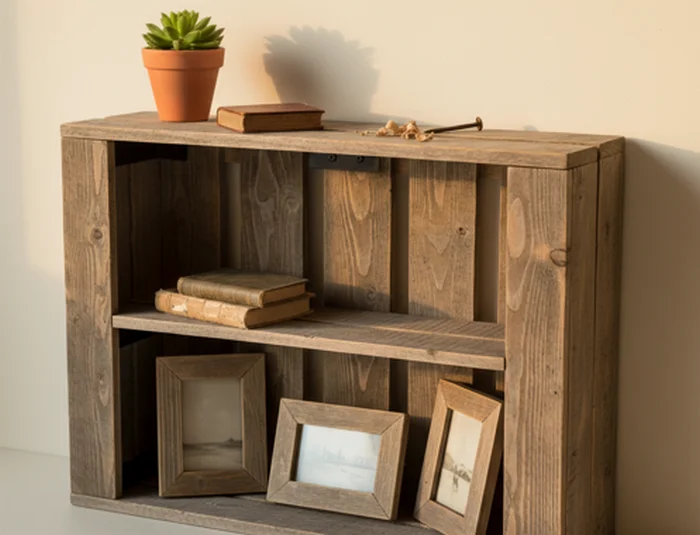
Woodworking can be a delightful and rewarding hobby, especially for beginners looking to blend creativity with craftsmanship. The good news is that you don’t need to invest a lot of time or money to kickstart your woodworking journey. Here are some creative ideas for free easy woodworking projects that beginners can try out.
Simple Wooden Planters
Creating wooden planters is a fantastic and easy project for beginners. You only need a few wooden boards, nails, and a saw. Not only do they add charm to your space but also allow you to showcase your plants.
- Materials: Wooden boards (reclaimed if possible), nails, wood glue, sandpaper.
- Steps:
- Cut the boards to your desired size.
- Nail the pieces together to form a box.
- Sand the edges for a smooth finish.
- Paint or stain if desired.
Birdhouses
Building a birdhouse is not only fun but also helps local wildlife. This project requires minimal materials and is a great way to improve your woodworking skills.
- Materials: Wooden scraps, nails, paint (optional).
- Steps:
- Cut the wood into six shapes: roof, base, and four walls.
- Assemble the walls to form a box.
- Attach the roof securely.
- Paint for aesthetics and weather protection.
Bookshelves
A small bookshelf is a useful project that can enhance your living area. You can make this with simple cuts and a little creativity.
- Materials: Wooden planks, wood screws, sandpaper.
- Steps:
- Decide the height and width of your shelf.
- Cut the boards accordingly.
- Screw together the sides and shelves.
- Sand edges to avoid splinters.
Picture Frames
Creating personalized picture frames is an easy project that can be tailored to fit any image. It’s a great way to use leftover wood from other projects.
- Materials: Thin wooden strips, wood glue, decorations (optional).
- Steps:
- Measure the size of your picture.
- Cut four strips according to the measurements.
- Join the strips at the corners using wood glue.
- Customize by painting or decorating the frame.
Wooden Toys
Crafting simple wooden toys is a fantastic way to practice your skills while creating something fun for kids. This can include cars, animals, or blocks.
- Materials: Wooden blocks, paint or color stains.
- Steps:
- Shape the wood into the desired toy design.
- Sand the edges for safety.
- Paint with non-toxic colors.
Wooden Coasters
Wooden coasters are practical and easy to make. They can add a rustic touch to your home and make perfect gifts.
- Materials: Thick wood slices or plywood, sandpaper, wood finish.
- Steps:
- Cut wood to your preferred size.
- Sand surfaces and edges.
- Add a finish for protection and style.
These projects are not only simple but also free or low-cost, making them ideal for beginners. Websites like Wood Magazine offer free plans and ideas that can help you get started. For additional references, check out Heartwood Tools for more free easy woodworking projects. Remember, woodworking is about having fun and creating, so don’t hesitate to let your imagination run wild!
Essential Tools for Woodworking: What You Need to Get Started
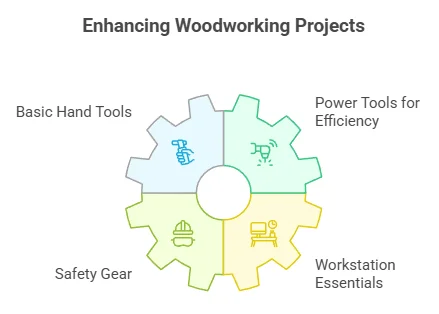
Woodworking is a rewarding hobby that allows you to create everything from furniture to fun projects. Whether you’re a complete novice or looking to refine your skills, having the right tools is essential. Knowing what tools to start with can boost your confidence and lead to successful projects. Here’s a deep dive into the essential tools you need to kickstart your woodworking journey.
Basic Hand Tools
Starting with hand tools, these are crucial for any woodworker. While power tools have their place, hand tools offer a level of precision and control that is hard to beat. Here’s a list of basic hand tools.
- Saw: A reliable hand saw is vital. Consider a pull saw, which gives you control and cleaner cuts.
- Chisels: A set of wood chisels ranging from 1/4 inch to 1 inch will help in carving and detailing.
- Plane: A hand plane smooths surfaces and can also reduce the thickness of wood.
- Measuring Tape: Accurate measurements are key to any project. A 25-foot measuring tape is usually sufficient.
- Square: A combination square helps ensure right angles and straight lines.
- Pencil: A woodworking pencil, which is thinner and leaves a fine mark for easy visibility, is ideal for marking cuts.
Power Tools for Efficiency
As you progress, adding power tools can streamline your woodworking process. Here are some power tools that are great for beginners:
- Cordless Drill: A versatile tool for drilling holes and driving screws. Look for a model with adjustable speed and torque settings.
- Jigsaw: Perfect for making curved cuts and intricate designs.
- Table Saw: Provides precise cuts on larger pieces of wood and is great for ripping boards.
- Router: A fantastic tool for hollowing out an area in the wood, edge trimming, and joint making.
Safety Gear
Safety should always come first in woodworking. Make sure you have appropriate safety gear to protect yourself when working with wood. Here’s what you need:
- Safety Glasses: Protects your eyes from flying debris.
- Ear Protection: Power tools can be loud, so consider earplugs or earmuffs.
- Dust Mask: Prevents inhalation of wood dust that can be harmful to your lungs.
- Gloves: Use gloves that provide a firm grip while allowing for dexterity.
Workstation Essentials
A well-organized workstation can make your projects easier and more enjoyable. Here are some essential features:
| Item | Purpose |
|---|---|
| Workbench | A sturdy surface for working and assembling projects. |
| Clamps | Secure your projects in place while gluing or cutting. |
| Lighting | Good lighting is crucial for seeing details clearly. |
Organizing Your Tools
Once you’ve gathered your tools, organization is key. Use toolboxes, pegboards, or saw horses to keep your workspace tidy. An organized space not only boosts productivity but also ensures safety when accessing your tools.
Where to Learn More
Embarking on your woodworking journey will be easier with resources at your fingertips. Websites like Wood Magazine and Woodworker’s Source offer tutorials and project ideas tailored for beginners. They provide a wealth of knowledge to help you learn and grow as a woodworker. The right tools and safety measures will set you up for success. Remember, every expert was once a beginner. Start with these essential tools, and enjoy the satisfying and creative world of woodworking!
Sustainability in Woodworking: Using Reclaimed and Free Materials
Woodworking is a rewarding hobby that not only lets you express your creativity but also provides a way to create sustainable and eco-friendly projects. One of the best approaches to achieve environmental responsibility in woodworking is by utilizing reclaimed and free materials. This practice not only helps reduce waste but also brings a unique charm and character to your creations.
Benefits of Using Reclaimed Wood
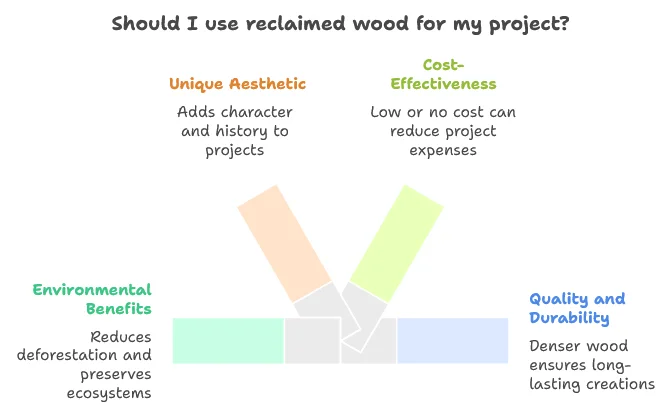
Reclaimed wood is sourced from old buildings, pallets, and other wooden structures that are no longer in use. Here are some compelling reasons to consider using reclaimed materials:
- Environmentally Friendly: By choosing reclaimed wood, you reduce the need for new lumber, preserving forests and the ecosystem.
- Unique Aesthetic: Reclaimed wood often has a beautiful patina and history, lending a distinct character to your projects that new wood simply cannot replicate.
- Cost-Effective: Often available for little to no cost, reclaimed materials can significantly reduce your project expenses.
- Quality and Durability: Older wood tends to be denser and harder, resulting in sturdy and long-lasting creations.
Where to Find Reclaimed Materials
Locating reclaimed wood doesn’t have to be a daunting task. There are various places you can look:
- Salvage Yards: These specialized warehouses often sell salvaged materials at low prices.
- Online Marketplaces: Websites like Reclaimed Wood Exchange offer options for finding local suppliers.
- Local Builders: Many contractors discard old wood during renovations. Connect with them to potentially score free or inexpensive materials.
- Pallets and Crates: Many businesses dispose of pallets and crates. Check local stores, or inquire at warehouses; they are often happy to give them away.
Free Materials for Woodworking Projects
Besides reclaimed wood, many other free materials can be fun and creative for woodworking. Here are a few ideas:
- Scrap Wood: Inquire at local hardware stores for leftover scraps. They’re often happy to let you take what you need.
- Old Furniture: Repurposing furniture instead of throwing it away can provide high-quality, seasoned wood.
- Construction Sites: Speaking to contractors about scrap or leftover wood can sometimes yield treasures.
- Community Giveaways: Keep an eye on local community boards and social media for events offering free materials.
Easy Woodworking Projects with Reclaimed and Free Materials
Once you’ve gathered your materials, the next step is to decide on a project. Here are some easy ideas to inspire you:
- Bookshelves: Use reclaimed wood planks to create rustic bookshelves. Simple brackets can hold the shelves, making this a functional project.
- Garden Planters: Convert old pallets or crates into unique and stylish planters for your garden.
- Picture Frames: Create beautiful, custom picture frames from old wood pieces, displaying your favorite memories with flair.
- Wooden Benches: Combine a few sturdy planks to fashion a simple bench for your garden or porch.
Tips for Working with Reclaimed Wood
Working with reclaimed materials does have its challenges. Here are some tips to make your projects successful:
- Inspect Thoroughly: Check for signs of rot, bugs, or damage before starting your project.
- Clean the Wood: Remove nails, dirt, and any contaminants. A good sanding usually does the trick.
- Use the Right Tools: Proper tools can make all the difference. Ensure you have a good saw, drill, and sander for the best results.
Step-by-Step Guides for Popular Easy Woodworking Projects
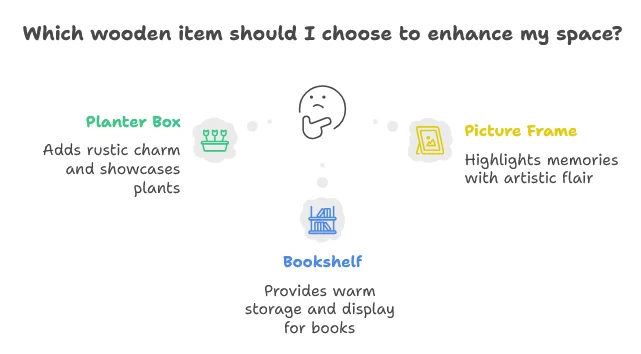
Woodworking can seem intimidating, but it doesn’t have to be! By starting with free easy woodworking projects, you can gradually build your skills and confidence. Here are a few popular woodworking projects, complete with step-by-step guides to help you get started.
Simple Wooden Planter Box
Creating a planter box is an excellent project for beginners. It is not only simple but also adds a decorative touch to any garden or balcony. Here’s how to make one:
Materials Needed:
- 4 pieces of 1×6 boards (length of your choice)
- Wood screws
- Wood glue
- Saw
- Drill
- Sandpaper
- Wood finish (optional)
Steps:
- Cut the boards to your desired length.
- Lay two boards parallel to each other to form the sides.
- Attach the other two boards perpendicular to the end of each side using wood screws and glue.
- Add additional screws for extra stability.
- Smooth any rough edges with sandpaper.
- Finish with a wood seal, if desired.
For more ideas on woodworking, check out Wood Magazine.
Cozy Wooden Bookshelf
Building a bookshelf can enhance your home while showcasing your handiwork. Here’s how to make a basic version:
Materials Needed:
- 2 pieces of plywood for the sides
- 3 pieces of plywood for the shelves
- Wood screws
- Wood glue
- Saw
- Drill
- Sandpaper
- Paint or stain (optional)
Steps:
- Cut the plywood to size, depending on how tall and wide you want the bookshelf.
- Attach the shelves to the side pieces, ensuring they are level.
- Secure the structure with screws and glue for added strength.
- Sand the edges and surfaces until smooth.
- Apply paint or stain to finish and personalize your bookshelf.
For more intricate designs and inspiration, visit Popular Woodworking.
Wooden Picture Frame
Frames are simple yet fulfilling projects that allow you to display your favorite memories. Follow this guide to craft your own wooden frame:
Materials Needed:
- 1×2 boards (for frame)
- Wood screws
- Wood glue
- Glass or acrylic sheet
- Backing material
- Saw
- Drill
- Sandpaper
- Picture to display
Steps:
- Cut the wood to create four pieces for the frame.
- Joint the corners at 45-degree angles for a clean finish.
- Glue and screw the pieces together.
- Place the glass or acrylic in the back of the frame, followed by your picture and backing material.
- Secure everything in the back with small nails or screws.
- Finish by sanding and painting or staining the frame, if desired.
Need more tips on woodworking? Check out Woodworkers Source for more projects. These step-by-step guides for popular free easy woodworking projects provide a solid foundation to ignite your creativity. Remember, the key is to have fun and learn as you go. Enjoy transforming basic materials into something wonderful!
Building a DIY Workshop: Setting Up a Space for Easy Woodworking at Home
Creating your own DIY workshop can be an exciting and rewarding endeavor, especially if you’re interested in free easy woodworking projects. A well-organized space will help you harness your creativity and make woodwork a more pleasurable experience. Below are steps and essential tips to set up your woodworking workshop at home.
Choosing the Right Space
The first step in building a DIY workshop is selecting the right space. Consider these factors:
- Size: Ensure you have ample room for your projects. A space of at least 10×10 feet is ideal for basic woodworking.
- Lighting: Good lighting is crucial. Natural light is excellent, but you should also have bright, adjustable LED lights for detailed tasks.
- Ventilation: Proper airflow will help eliminate sawdust and odors. If possible, choose a space with windows that can be opened.
Essential Tools for Your Workshop
While free easy woodworking projects can be tackled with minimal tools, having the right equipment makes a substantial difference. Here’s a list of essential tools you should consider:
- Hand tools: Saws, chisels, hammers, and screwdrivers.
- Power tools: Circular saw, jigsaw, and cordless drill.
- Workbench: A sturdy workbench to hold your materials securely.
- Clamps: Useful for holding pieces together while gluing or cutting.
Organization Tips
Keeping your workspace organized can help you focus on your projects. Implement these simple tricks:
- Storage Solutions: Use tool racks, pegboards, and shelving units to store your tools neatly.
- Label Everything: Clear labels can save you time by quickly identifying where everything is.
- Work Zones: Create specific zones for cutting, assembly, and finishing to keep tasks streamlined.
Safety First!
No workshop is complete without safety measures. Always keep the following in mind:
- Protective Gear: Always wear safety glasses and ear protection when operating tools.
- Fire Safety: Keep a fire extinguisher handy and know how to use it.
- First Aid Kit: Equip your workshop with a basic first aid kit for emergencies.
Inspiration and Resources
If you’re looking for free easy woodworking projects to get started, many resources are available online. Consider visiting sites like:
- Wood Magazine – Offers extensive project ideas and detailed plans.
- Instructables – Features user-generated projects, including woodworking tutorials.
- Ana White – Specializes in DIY furniture plans that are simple and easy to follow.
Setting Up Your Workshop
Once you’ve chosen your space and gathered your tools, it’s time to set up your workshop. Follow these steps to lay out an efficient workspace:
| Step | Action |
|---|---|
| 1 | Organize tools based on frequency of use; keep the most-used items within arm’s reach. |
| 2 | Place your workbench in a central position to maximize access to your tools. |
| 3 | Set up additional lighting around your workbench for precise tasks. |
| 4 | Introduce power outlets for easy access to electric tools. |
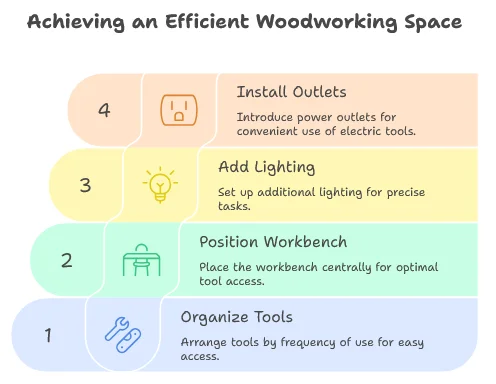
Establishing a DIY workshop in your home can open up a world of creativity. With careful planning and organization, you can embark on various free easy woodworking projects. Whether you’re making simple furniture or intricate decor, the right setup will empower you to explore your capabilities and enjoy woodworking to the fullest.
Conclusion
Embarking on your woodworking journey can be an incredibly rewarding experience, especially with the plethora of free, easy projects available for beginners. With creative ideas that spark your imagination, you’ll find that woodworking is not just a craft, but also a form of art. Utilize the essential tools outlined, which are vital for honing your skills and turning projects into reality.
Remember, starting out doesn’t have to break the bank—using reclaimed and free materials allows for a sustainable approach while also giving a unique character to your creations. As you dive into step-by-step guides for popular projects, you’ll discover how straightforward and satisfying it can be to create something with your own hands. Each project serves as a building block, helping you gain confidence and improve your craft with every cut and joint.
Setting up a DIY workshop can further enhance your woodworking experience. A designated space, equipped with the right tools and materials, fosters creativity and allows you to dive deeper into this fulfilling hobby. Whether it’s creating functional furniture, decorative items, or simple gifts, the possibilities are endless.
Ultimately, woodworking combines creativity and practicality, providing countless opportunities for self-expression. So grab your tools, explore those free easy woodworking projects, and enjoy every moment spent crafting something special. You’ve got this, and we can’t wait to see what you create!